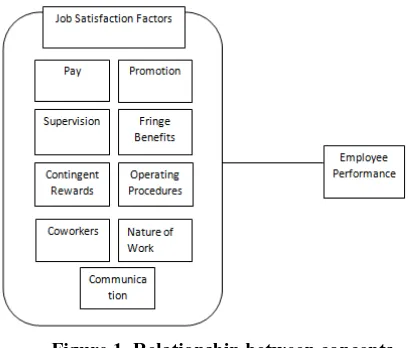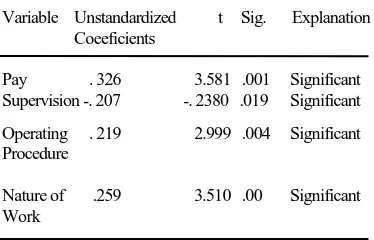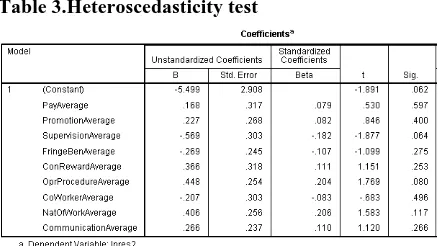325
The Impact of Employee Job Satisfaction towards Employee Job Performance at
PT.Y
Devilan Sutjitra
International Business Management Program, Petra Christian University Jl. Siwalankerto 121-131, Surabaya
E-mail: [email protected]
ABSTRACT
This research is done to analyze The Impact of Employee Job Satisfaction towards Employee Job Performance at PT.Y. The decreasing in employee job performance for the past 3 years has indicated the author to analyze the impact of employee job satisfaction towards job performance. The elements that used are 9 job satisfactions to measure the impact of satisfaction at PT.Y. The author got 100 respondents from PT.Y and use simple random sampling method.
The analysis technique that used in this research is multiple linear regression analysis to describe the relationship between job satisfaction and job performance. The result of this research is show significant impact of employee job satisfaction towards employee job performance.
Keywords: Job satisfaction, Job performance, Employee, Spector’s Theory
ABSTRAK
Penelitian ini dilakukan untuk menganalisa Dampak Kepuasan Kerja Karyawan terhadap Performa Kerja Karya wan di PT.Y.Adanya penurunan performa kerja yang telah terjadi 3 tahun terakhir menarik perhatian peneliti menganalisa dampak kepuasan kerja yang berpengaruh terhadap performa kerja.Elemen yang digunakan adalah 9 job satisfaction untuk mengukur Dampak Kepuasan Kerja Karyawan di PT.Y. Dari kuisioner yang telah tersebar, peneliti menda patkan 100 responden dari PT.Y dengan menggunakan metode simple random sampling.
Teknik analisa yang digunakan dalam penelitian ini adalah multiple linear regression analysis untuk menjelaskan hubungan antara kepuasan kerja dan performa kerja.Hasil dari penelitian ini menunjukkan dampak yang signifikan pada kepuasan kerja terhadap performa kerja.
Kata kunci : Kepuasan kerja, Performa kerja ,Karyawan, Teori Spector
INTRODUCTION
In timber manufacturer, employee has important roles to run the mill and producing the woods. It is very important for the company to make sure the entire employee to work the best. Since all the productions are being done by the employee.Moreover, human capital can affect the effectiveness and efficiency of the company because human capital is the assets to utilize the resource that company has. In order to do that, highly satisfied work force is an absolutely necessity for achieving a high level of performance advancement of an organization (Pushpakumari, 2008). Employee Job satisfaction can be defined as the degree of needs satisfaction that is derived from and or experienced on the job (Dessler, 1978). The satisfied employee will enhance their productivity and quality of work. To get employee satisfaction, an organization needs to recognize about what employee think, feel, and desire.
Furthermore, an organization must recognize what factors that influence the job satisfaction. As an example, a company that gives high salaries and good working environment is possible to have satisfied work force (Luthans, 1985). Moreover, if company can maintained the employee satisfaction it can impact in give greater effort to job performance (Pushpakumari, 2008). Employee performance is crucial factors in increasing the overall organization performance. When an employee is able to perform effectively and understand more the job that expected to meet, it means they have good job performance and know how to satisfied customers and give benefits to company (Pushpakumari, 2008).
326
LITERATURE REVIEW
There are many different definitions of Job satisfactions defined by scholars. One of the most definitions used is from Locke (1976) who states that job satisfaction is positive affect that employees have towards their jobs. It is also stated by Schermerhorn et al.(1991)That Job Satisfaction is the degree to which individuals feel positively or negatively about their jobs. It means that, how individuals’ satisfaction can be measured from highly satisfied until dissatisfied in one’s task and with their workplaces. Furthermore, the theory of job satisfaction from Spector (1997) stated that job satisfaction can be defined as a feeling from employee about different aspects of their jobs. He continued stating that Job Satisfaction Survey can be used to measure the satisfaction feelings of the people towards job. There are 9 facets of satisfaction can be found in Spector’s Job Satisfaction Theory : pay,promotion,supervision, fringe benefits, contingent rewards, operating procedures, coworkers, nature of works, and communication.
According to Porter and Lawler (1967), employee performance can be defined as the work of employee ability and skills in any given tasks. In addition, organizations can see how well the employees perform during their work (Jex, 2002).Job performance also can be defined as the result of individual’s work in terms of quality and quantity (Mangkunegara, 2001) .Moreover, employees are valuable asset in organizations because to achieve long-term goals it will be depends on how well is the performance of each individual (Pushpakumari, 2008). She continued by stating that employee who able to perform effectively and understand the job, it means they have good job performance and knowhow to satisfied customers and give benefits to company. Furthermore, by measuring the employee performance the organizations will know what to improve in the company so they can achieve the goals. According to U.S Office of Personnel Management (2011) employee performance can be measured from the outputs and activities. In outputs, the organization can measured it from how much is the output can be produced by the employee.
Below is the relationship between both theories that author has constructed.
Figure 1. Relationship between concepts
The author has developed two hypotheses regarding the research outcome, which are:
H1: employee satisfaction factors simultaneously influence employee performance at PT.Y
H2: employee satisfaction factors individually influence employee performance at PT.Y
RESEARCH METHOD
The author wantsto analyze the relationship between job satisfaction and job performance at PT.Y through theories and by conducting hypotheses testing. Based on the types of research method, conduct explanatory study is suitable with this research.
Explanatory research explained causal relations between variables with hypothesis testing by conduct survey in order to find the final result of the relationship of variables used in the research. To collect the data, the simple random probability sampling method is suitable to fit the research design because in random sampling method the chance to be selected is equals to every individual.
Furthermore, nominal scale is used to identify the respondents’ profile by grouping the screening questions .The interval scale covers the questions prepared by author by using likert scale.
To determine the sample size, the author will use Slovin’s formula (Husein, 2005)
� =
1 + Ne
N
2Where:
n = Sample of population N= Number of Population
e = Tolerance of error level (α =95% ; e = 5%)
327 value from corrected item total correlation, the author can get concluded it is valid if the value in corrected item total correlation is higher than value from r-table. Meanwhile, reliability test is conducted to analyze whether the instruments used are free from random error and consistent. This test indicated the consistency when the Cronbach’s Alpha is closer to 1.Furthermore, if the Cronbach’s Alpha is indicated higher than 0.6(Sekaran & Bougie, 2009) it is acceptable as reliable and those above 0.8 are good.In contrast, when cronbach’s alpha is indicated lower than 0.6, it can be concluded as irrelevant
RESULTS AND DISCUSSION
Based on the results from regression analysis, there are 4 factors that affect employee job performance such as pay, supervision, operating procedures and nature of work. After conducting classical assumption test, the author has found the results for this research is passed the cut off point for each of assumption tests. The validity test is above the value in r-table where the author got from d(f)= 100-2 with r-value is 0.1966. For the reliability test, the entire variable is above 0.6. It is can be concluded that the entire variable is valid and reliable. This finding is different with the result of the previous research done by Khan, Nawaz, Aleem, Hamed (2011). In this research, promotion has no significant relationship with job performance. Moreover, co-workers also have no significant relationship with job performance which has the same finding with the author. However, in this previous research nature of work has significant relationship with job performance. This finding has the similarity with one of the finding results done by the author. In addition, from the finding result done by Pushpakumari(2008) the significant influence that affecting the organization to reach better job performance is financial benefits, which is means pay factor in this research. Pay itself can increase the productivity of the workers Lazear (2000). Furthermore, she also revealed that financial benefits has 20.06% has greater affect for the private sector employee in Sri Lanka to attend the work. In this research the beta value for standardized coefficient, pay contributes the .326 which is the highest to the variation of dependent variable. The value of pay indicates the highest significant t followed by nature of work, operating procedures and supervision. It means that pay give significant impact towards employee job performance.Below is the table of t-test result from regression analysis
Table 1. T-Test Result
Variable Unstandardized t Sig. Explanation Coeeficients
Pay . 326 3.581 .001 Significant Supervision -. 207 -. 2380 .019 Significant
Operating . 219 2.999 .004 Significant Procedure
Nature of .259 3.510 .00 Significant Work
Table 2. Multicollinearity test
Based on the results, all the correlations values between independent variables are following the value of VIF and tolerance. The minimum limit for tolerance value is higher than 0.1. In addition, VIF is not higher than 10. Thus, the independent variables are not correlated each other and the multiple regression model used are reliable enough to be used in the further analysis
328
Table 3.Heteroscedasticity testPark test can be used to examine whether there is existence of heterocedasticity or not. Theoretically, the significance F (p-value) shown in the SPSS output is higher than 0.05 then it is strongly homoscedasticity. In contrast, if the significance F (P-value) is lower than 0.05, there is heteroscedasticity. Based on the table 4.25 below, the results is indicated the homoscedasticity. As shown in the significance column is higher than 0.05. Thus, there are no heterocedasticity in this regression model.
Table 4. Skewness and kurtosis results
The next tools to examine the data are skewness and kurtosis statistic.The residuals of the data are considered as normally distributed if the skewness and kurtosis ratio are between -2 and 2. The result obtained from the computation shows is as shown in the table 4 above
After got the results from the computation, the skewness ratio is 1.65.For the kurtosis ratio is -0.90 both ratios are shown between -2 and 2 which mean that the residuals of the data are normally distributed.
Table 5. F-test results
The confidence level in this research is 95% (Ghozali, 2011). Therefore, the significance level is 0.05. The result of hypothesis above can be known after Significance F (P-value) is compared to the significance level. When, significance F (P-value) is less than 0.05 and then H0 is rejected. On the other hand if significance F (P-value) is more than 0.05 and then the H0 is not rejected. Based on the result in table 5 above, the significance-F indicates value which is much lower than the 0.05. Therefore, using this approach in measuring the significance level, there is significant relationship between job satisfactions with job performance.
Table 6. Adjusted R square (coefficient determination)
The result for the adjusted R square, as shown in table 4.27 below, which indicates 52.2% of the variation in the job satisfaction of PT.Y can explain the variation in the job performance
As shown by the result of adjusted R square, 52.2% of the variation in the job satisfaction can explain the job performance. It means there are 47.8% of other variables outside the regression model that have influence towards job satisfaction towards PT Y.
CONCLUSION
329
REFERENCES
Aftab, H., & Idrees, W. (2012). A Study of Job Satisfaction and IT’s Impact on the Performance in the Banking. International Journal of Business and Social Science , 174-180.
Ammons, D. (2006). Performance Measurement: A Tool for Accountability and Performance Improvement. Retrieved April 2, 2015, from Country and Municipal Government in North
Carolina Web Site:
www.sogpubs.unc.edu/cmg/cmg16.pdf Armstrong, M. (1999). Human Resource Management
Practices 9th edition. London: KoganPage. Arnold, H., & Feldman, D. (1986). Organizational
Behavior. New York: McGraw Hill.
Bako, A. A. (2014). Australian Society for Commerce Industry and Engineering. The Positive and Negative Effects of Job Satisfaction on
Employee’s Performance in an Organization ,
45-49.
Baron, A., & Greenberg. (2003). Organizational Behavior in Organization : Understanding and Managing the Human Side of Work. Canada: Prentice Hall.
Burton, G. E., Pathak, D. S., & Zigli, R. M. (1976). The Effects of Organizational Communication on Job Satisfaction and Motivation Factors for Management. Journal of Management , 17-23. Clark, A., & Oswaled, J. (1996). Satisfaction and
comparison income. Journal of Public Economics , 359-381. Schindler, Business Research Methods (p. 86). New York: McGraw-Hill Education.
Cooper, D. R., & Schindler, P. S. (2014). Business Research Methods. New York: McGraw-Hill Education.
Deci, E. L., Koestner, R., & Ryan, R. M. (2001). Extrinsic Rewards and Intrinsic Motivation in Education : Reconsidered Once Again. Review of Education Research , 1-27.
Dessler, G. (1978). Personnel Management, Modern Concept and Techniques. Virginia: Reston Publishing Company Inc.
Dickson , W. J., & Roethlisberger, F. (1941). Management and the Worker. The Economic Journal , 306-308.
Eisenberger, R., Stinglhamber, F., Vandenberghe, C., Sucharski, I. L., & Rhoades, L. (2002). Perceived supervisor support: Contributions to perceived organizational support and employee retention. Journal of Applied Psychology , 565-573.
Fraza, V. (1997). Satisfaction Guaranteed? Industrial Section , 66-70.
George, D., & Mallery, M. (2010). SPSS for Windows Step by Step: A Simple Guide and Reference, 17.0 update . Boston: Pearson.
Ghozali, I. (2011). Aplikasi Analisis Multivariate dengan Program IBM SPSS 19. Semarang: Badan Penerbit Universitas Diponegoro. Gray, J., & Laidlaw, H. (2004). Improving the
Measurement of Communication Satisfaction. . Management Communication Quarterly , 425-448.
Gupta, I. (2014). Impact of Job Satisfaction on Employee's Performance. Scholarly Research Journals for Interdisciplinary Studies , 2307-16.
Gupta, N. (1975). The Impact of Performance - Contingent Rewards on Job Satusfaction : Direct and Indirect Effects. University of Michigan , 118-153.
Hakala, D. (2008, February 19). 16 Ways to Measure Employee Performance. Retrieved April 2, 2015, from Tompkins Countyny.gov: TompkinsCountyny.gov/files/workforceny/16 Ways to Measure Employee Performance.pdf Hertzberg, E. (1979). Motivation and Innovation :
Who are workers serving? California Management Review , 60-70.
Husein, U. (2005). Metode Penelitian untuk Skripsi dan Tesis Bisnis. Bandung: PT. Raja Grafindo Persada.
Jex, S. (2002). Organizational Psychology: A Scientist-Practitioner Approach. New York: John Wiley & Sons.
Judge, T., Bono, J., & Locke, A. (2000). Personality and job satisfaction: The mediating role of job characteristics. Journal of Applied Psychology , 237-249.
330
Jex, S. (2002). Organizational Psychology: AScientist-Practitioner Approach. New York: John Wiley & Sons.
Khan, A. H., Nawaz, M. M., Aleem, M., & Hamed, W. (2011). Impact of job satisfaction on employee performance:An empirical study of autonomous Medical Institutions. African Journal of Business Management , 2697-2705. Kavanaugh, J., & Duffy, J. A. (1999). Employee
Satisfaction : Strong Benefits are Important But May Not Be Enough . Gibson D.Lewis Centre for Business and Economic Development , 1-23.
Kosteas, V. (2011). Job Satisfaction and Promotions. Industrial Relations : A journal of Economy and Society , 174-194.
Kothari, C. R. (2004). Research Methodology Methods and Techniques. New Delhi: New Age International (P) Limited.
Kothari, C. (2004). Research Methodology : Methods and Techniques. New Delhi: New Age International (P) Limited.
Lacey, M. (1994). Rewards can cost nothing?Yes they can.. really! The Journal for Quality and Participation , 6-9.
Lazear, E. P., & Sherwin, R. (1981). Rank-order tournaments as optimum labor contracts. Journal of Political and Economy , 841-864. Lazear, E. (2000). Performance Pay and Productivity.
American Economic Review , 1346-61. Locke, E. (1976). The Handbook of Industrial and
Organizational Psychology. New York: Wiley. Luthans, F. (1985). Organizational Behavior. McGill
Illinois.
Majeed, S., Saleem, S., Aziz, T., & Usman, M. (2013). Determinants of Job Satisfaction among Employees of Banking Industry at Bahawalpur. Journal of Emerging Issues in Economics, Finance and Banking , 150-162. Mangkunegara, A. A. (2001). Manajemen Sumber
Daya Manusia Perusahaan. Bandung: PT.Remaja Rosdakarya.
Martins, N., & Coetzee, M. (2007). Organisational culture, employee satisfaction, perceived leader emotional competency and personality type : An exploratory study in South African engineering company. South Africa Journal of Human Resource Management , 20-32.
Masterson, S. S., Lewis, K., Goldman, B. M., & Taylor, M. S. (2000). Integrating Justice and Social Exchange: The Differing Effects of Fair Procedures and Treatment on Work Relationships. ACAD Manage J , 738-748. Muhammad, N., & Akhter, M. (2010). Supervision,
Salary and Opportunities for Promotion as Related to Job Satisfaction. ASA University Review , 255-261.
Noe, R., Hollenbeck, J. R., Gerhart, B., & Wright, P. M. (2012). Human Resource Management : Gaining a Competitive Advantage. In R. Noe, J. R. Hollenbeck, B. Gerhart, & P. M. Wright, Human Resource Management : Gaining a Competitive Advantage (pp. 465-466). United Kingdom: McGraw Hill Education.
Oshagbemi, T. (2000). Correlates of pay satisfaction in higher education. International Journal of Education Management , 31-39.
Pergamit, M., & Veum, J. (1999). What is a Promotion? Industrial and Labor Relations Review , 581-601.
Porter, L., & Lawler, E. (1967). The Effect of Performance on Job Satisfaction. Industrial Relations , 20-28.
Pushpakumari, M. (2008). The Impact of Job Satisfaction on Job Performance : An Empirical Analysis. 89-105.
Schermerhorn, John, James, Hunt, G., & Osborn, R. N. (1991). Managing Organizational Behavior. United States: John Wiley and Sons Inc.
Spector, P. (1997). Job Satisfaction : Application, Assesment, Cause, and Consequences. Thousand Oaks, CA: SAGE Publications. U.S Office of Personnel Management. (2011,
September). A Handbook for Measuring Employee Performance. Retrieved April 2, 2015, from OPM.gov: www.opm.gov/policy-


